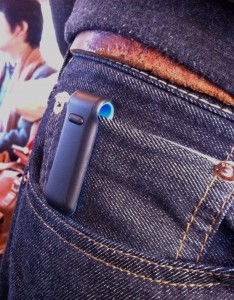The Fitbit in the library – maybe

“Fitbit Ultra – teal” by Ashstar01 – Own work. Licensed under Creative Commons Attribution-Share Alike 3.0 via Wikimedia Commons
Personal devices are the hot new consumer electronic trend right now. Some show really great promise at solving certain medical problems. Others just further propel people toward increased internet connectivity and socialization. These devices present problems for libraries in many of the some ways that tablets, ipods, and laptops do. There is the increased bandwidth demand the second someone walks into the library with their iphone, tablet, and smartwatch all wifi enabled at the same time demanding synchronization updates, geolocation services, and the current time. But for some library patrons who are not tech savvy, they bring their unboxed devices to setup at the library. Either from lack of knowledge on how to do it, lack of companion equipment, or no Internet at home, library staff have to get educated quickly on setting up unfamiliar devices. I’ve run into myriads of problems with helping people setup their devices, though usually resolved after some time. And then I had trouble with my own.
I recently acquired a Fitbit. A Fitbit is a personal activity monitor, also known as a fancy electronic pedometer. It aggregates data, syncs with devices, looks very cool, and is a small, wearable device. Syncing the device to the Fitbit service allows an individual to track activity through fancy charts and set goals. And then it has the usual socialization options, though I wonder how many would care to read about my steps progress on Facebook and Twitter?
I was most excited about the wireless syncing options. The official website claimed that I could sync my device through my Android devices with Bluetooth. I assumed that I would also be able to setup my device via the Fitbit App. Both expectations immediately failed. Upon unboxing the device, I quickly discovered that I had to setup my device on a Windows based machine*. My house no longer contains a Windows machine (we are Linux primarily) and as usual, the Fitbit is not Linux friendly. I could not setup the device via the App either. All the app was good for was looking at those pretty charts and notifying my Facebook friends about my steps progress (#bigfail). So down to the library I went. I can’t remember how I setup the device exactly, but I managed to get it setup on a Windows machine in our back office. It required downloading some software and turning the device on.
So I wore the device for a few days hoping that I could sync my device via Bluetooth on my Android tablet to the Fitbit App. Again, another #bigfail. I used a brand new, hot off the manufacturing belt, Google Nexus 10 tablet with Bluetooth and discovered the devices could not talk to each other. They had different versions of Bluetooth with the Fitbit device having a specialized version. Further research showed that most Android devices do not have the latest Bluetooth, and in fact, only a few devices actually work wirelessly with the Fitbit (#bigfail). The only way I could sync my device to the Fitbit app was to, counting steps the whole way, trek down to the library and attach it to the office computer via a specialized dongle.
By this time I was getting a bit frustrated. I had a device that was supposed to be easy to use and is supposed to sync and interact with my other devices, and it clearly did not. Further research revealed some rather disturbing privacy and usage practices for the Fitbit company. Any data that you aggregate and sync to your Fitbit account becomes the property of Fitbit. They reserve the right to use that data for any purpose. If you want access to it offline to send to, say, your doctor, you have to pay for it.
So with all this, I boxed my fitbit back up and sent it back to the company. The device was no longer convenient, or easy, to use and had some appalling privacy issues. I was amused to see my device did somehow sync (security issue?) with something, because it managed to log 32,000 steps as it travelled back to the warehouse. I then used my refund to buy a simple $20, low-tech pedometer that tells me, and only me, what I need to know. Some devices, such as iPhones, now integrate activity monitoring, rendering the need for a Fitbit moot.
What about library patrons? How do we help them use and understand these types of devices? Are we seeing the transformation of library services to include technical guidance on purchases?
Oh, and don’t forget the number one tech rule! Make sure that any device you buy will work with what you already own.
*Supposedly, you can set the device up via a Mac, but since I don’t own one, I can’t test it out.

